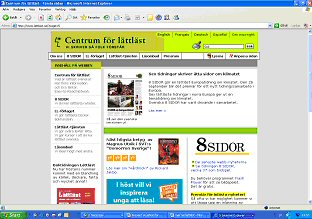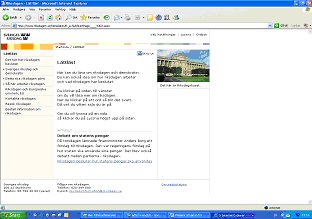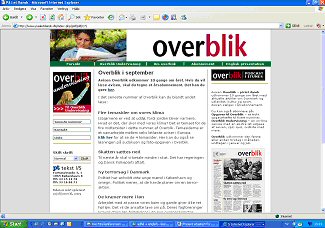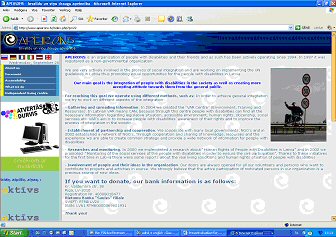Abstract [Resum] [Resumen]
The easy-to-read (ETR) movement in five northern European countries (Sweden, Norway, Denmark, Finland and Latvia) is compared. The existence and characteristics of ETR publishing companies, periodicals and specialised organisations are analysed. Furthermore, the following are described for each country: the concept of ETR; the groups it is aimed at; and the role of governments and official institutions in providing funding. Strategies for developing ETR are proposed, according to the target group. In addition, the styles of writing and presentation required by this type of publication are explained. More research is needed in this area. One model for ETR could be the projects that have been carried out by another reading-related international movement: the plain language movement, which has drawn up internationally accepted guidelines.
1 Introduction
The easy-to-read concept is almost the same in Sweden, Norway, Denmark, Finland and Latvia. But there are differences. Both within the countries and between them. It comes down to having different target groups and different strategies of organising the work. Also, the general awareness of reading problems and the need for easy-to-read seems to be very different in different countries.
1.1 Sweden
Sweden has had a national strategy for writing and distributing easy-to-read books and newspaper articles since the 1960's, and since the 1980's one of Sweden's easy-to-read organisations, The Centre for easy-to-read, Centrum för Lättläst, in Stockholm, has had financial support from the Swedish parliament. This has made it possible to publish about 30 books a year, plus a weekly newspaper of about 14 000 copies with more than 120 000 readers. The Centre for easy-to-read also offers short courses in and about easy-to-read. Twice every year it arranges courses for different professional groups.
The centre for easy-to-read also has a system of reading representatives, who read books for people that are otherwise difficult to reach, like old people and disabled people in institutions. These representatives are primarily recruited among staff in group housing and at day care centres. The task of the reading representatives is to stimulate interest in reading, arrange reading periods with reading aloud, visits to libraries, etc. The reason for the work is to awaken an interest in reading.
Figure 1. Centrum för Lättläst <www.lattlast.se>
In Sweden there are also other organisations that write easy-to-read. For example the newspaper Sesam, whose target group is adult immigrants.
Figure 2. Sesam <www.sesam.nu>
Also, many of the Swedish authorities, both governmental and local, publish information in easy-to-read. Most government authorities now have the most important information on their web sites in easy-to-read and some are really committed, like the Swedish parliament whose information managers publish all decisions in brief and all their press releases in easy-to-read.
Figure 3. Sveriges Riksdag <www.riksdagen.se>
The Swedish radio also has daily news in easy-to-read, Klartext, every evening at six o'clock. More than 300 000 people listen to the program every evening. The radio station also publishes all the news items on its web site, where you also can listen to the news if you prefer to do so.
Figure 4. Sveriges Radio <www.sr.se>
1.2 Norway
Norway resembles Sweden in many ways. Norway has an ambitious book publication and a national newspaper in easy-to-read. But they have organised the publishing in a different way from Sweden. Instead of having a publishing company in the ordinary way, Norway has an organisation that helps readers to find the book they want (Leser Søker Bok) through the web site <www.boksok.no>. The organisation co-operates with the literary community in Norway in finding good writers, preparing manuscripts and helping the publishing companies sell and market the books. And only a small part is written in easy-to-read. In Norway the publishing company and the newspaper are two different organisations, and both of them are well integrated into the mainstream publishing and newspaper world. The newspaper has its editorial office in the same place as Norway's equivalent to The Swedish Central News Agency.
Figure 5. Leser Søker Bok <www.boksok.no>
1.3 Denmark
Denmark has no publishing company that publishes books in easy-to-read, but they have a monthly national newspaper, Overblik, with an edition of 3 500 copies and 850 readers. The authorities have so far not been very interested in writing in easy-to-read, with a few exceptions. For example, the Danish constitution has been distributed to all 18-year-olds with an explanatory text in easy-to-read together with the ordinary text. You may also sometimes see the link "Let at lese" (easy-to-read) on some web sites of Danish authorities, but the text is not in easy-to-read at all, you only get the opportunity to make the letters bigger in order to see them better.
Figure 6. Overblik <www.paaletdansk.dk>
1.4 Finland
Finland has a centre for easy-to-read and a national newspaper in Swedish, LL-Bladet, with 1 500 readers (together with the Finnish easy-to-read newspaper the readers are over 5 000). As in Sweden, the newspapers gets funding from the state. A few years ago the Finnish radio had news in easy-to-read both in Swedish and Finnish, but now there is only news in easy-to-read in Finnish. (Finland has two national languages: Finnish and Swedish.)
Figure 7. Papunet <http://papunet.net>
1.5 Latvia
Latvia has a centre for easy-to-read in Riga, but no national newspaper. The big difference compared with the Nordic countries is that the Latvian centre gets no funding from the state. Apeirons is an organization of people with disabilities and their friends and has recently started, actively operating since 1994. In 1997 it was registered as a non-governmental organization. Apeirons is totally dependent on private funding for different projects. The work is voluntary and the centre has no employees, only people enrolled for different projects. The easy-to-read work is being developed along the same lines as the work for the disabled, which is quite new in Latvia. In 1996 they got their first centre of independent living for the disabled. In May, Apeirons had its new web site ready.
Figure 8. Apeirons <www.apeirons.lv>
2 Key factors for success
The easy-to-read work could be wider spread, more known and better used in all countries. Some of the problems are small target groups, lack of funding, lack of understanding of reading problems in general and of the easy-to-read concept, and lack of interest from parliaments, governments and agencies. Generally, there seems to be a lack of research and testing.
2.1 Different target groups
Different countries have different target groups. In Sweden, the target group for the Centre for easy-to-read is 25 per cent of the population, all with reading difficulties so severe that they cannot read a Swedish newspaper with enough understanding (that is, what is demanded of a 15-year-old pupil leaving compulsory school). This was stated in an international reading test from OECD in 1996, and among the 25 per cent there are elderly Swedes with little schooling, immigrants and people with reading difficulties due to for example dyslexia (difficulties in reading and writing), intellectual disabilities and lack of reading habits. The Centre for easy-to-read therefore has several target groups including the intellectually disabled, or those suffering from autism or aphasia, people who are dyslexic, people who are deaf from childhood, the elderly, immigrants and school children.
Finland has a smaller target group than Sweden, only 6–7 per cent of the population with severe reading difficulties. To begin with, the main target group was people with intellectual disabilities, but now easy-to-read targets school children and elderly people with dementia or intellectual disabilities. In Latvia, the target group is even smaller; the easy-to-read work is closely connected with the work for the disabled. In Denmark, the target group for the newspaper Overblik was originally limited to immigrants, but has now been widened to include teenagers and adults with reading problems in general, for example people with dyslexia. Norway has a wide target group, ranging from school children to elderly people with dementia and disabled people with visual impairment, dyslexia or concentration disorders (for example ADHD, Attention Deficit Hyperactivity Disorder).
It may be a key factor for success to widen the target group in order to gain more funding. Sweden with its big target group consisting of 25 per cent of the population has also gained great support and funding from the Swedish parliament. The different target groups probably affect the countries' easy-to-read concepts in different ways.
2.2 Funding and interest from parliaments, governments and agencies
Lack of funding seems to be the biggest problem in Latvia, who is the newcomer among the compared countries. Sweden, Norway and Finland all have state funding for their centres, publishing houses and newspapers.
In Sweden, the government has drawn up the charter for the Centre for easy-to-read and appointed its board of directors. The board includes politicians, representatives of handicap organisations and people who are professionally devoted to culture, the media or marketing. The operation is financed by income from sales and state grants.
A big problem for some countries is the lack of interest from parliaments, governments and agencies. In Denmark, the interest is low: there is no centre for easy-to-read and few authorities seem to understand the advantages of texts in easy-to-read. They seem to have another attitude towards the readers, where people have to learn the language if they cannot understand it. They accept the fact that many people have trouble reading, but they try to solve it by funding education instead of more easy-to-read texts. Perhaps it all comes down to not really understanding how the easy-to-read concept works.
2.3 Different ways of writing
Different countries write easy-to-read in different ways. This might be due to the fact that the languages are different, as well as to cultural factors. Here the Swedish way of writing easy-to-read is compared with the Finnish way.
In Sweden, the aim of the Centre of easy-to-read is to write simply and understandably, but at the same time in an adult and varied manner, and to use a combination of text and pictures. To achieve this, the content, language, pictures and the graphic layout are taken into consideration. The content is concrete, usually with a simple story-line. Few people and places are involved. The course of events is usually described in chronological order, i.e. no jumps in time such as from the present to the past. The language should also be concrete. Long, unusual words should be avoided, as well as concepts that may have two meanings. "He is a big actor" may mean that he is a large man or that he is well-known. Nor do easy-to-read texts use figurative language such as "build castles in Spain", since such phrases can be interpreted literally. The active voice is preferred, and the passive voice avoided. Short sentences are preferred to longer ones using subordinate clauses. One cannot assume that all readers are aware of places and countries or of dates. Such information must be placed in context: "1932 was when grandmother was young". Pictures are important in easy-to-read texts. Concrete pictures should illustrate clearly what a thing looks like, without irrelevant details and strange angles. It is important for form and layout to be well thought through. It is easier for the reader to absorb information if text and pictures are presented as clearly and with as much space as possible. Many readers have difficulty in noticing full stops and in reading long lines. An easy-to-read text is thus often written with line-feeds at the end of each phrase. A new line starts at a natural point in the sentence, and always after a full stop. The reader can then make a pause at the proper place.
Example of a Swedish text in easy-to-read (from the newspaper 8 Sidor):
Varannan svensk vill förbjuda slöja
Många svenskar vill förbjuda
muslimska kvinnor
att ha slöja i skolan eller på jobbet.
Det visar undersökningen
Mångfaldsbarometern som görs
varje år av Uppsala Universitet.Motståndet mot muslimska slöjor
har ökat lite sedan förra året.
Då svarade 45 procent att slöjor
skulle förbjudas.
I årets undersökning ville varannan
svensk förbjuda muslimska kvinnor
att ha slöja på jobbet eller i skolan.In Finland, the description of easy-to-read seems to be more similar to the description of plain Swedish than to the Swedish easy-to-read concept. For example, their way of writing easy-to-read does not try to abolish the passive voice, because it is quite common in Finnish. On the web site for the Centre for easy-to-read there is a short description of what easy-to-read is. The texts consider the content: what you are going to say and to whom, defining the topic, paying careful attention to the logic of the text. They also pay attention to vocabulary: using common and well-known vocabulary, avoiding long words and explaining difficult or abstract expressions. Simple structures are important: using easier grammatical cases and verb structures instead of more difficult ones. Sentences are short: only one important issue in one sentence, direct word order is preferred, the most important issue in the main clause and the specifications in the subordinate clause. The sentences should connect to each other logically. Coherency of the text is important: making the sentences and paragraphs consistent with each other by using different means of coherency, seeing that the structure of the text is logical, binding the subject to time and place, being concrete, giving examples. It is important to avoid references to other points in the text (this doesn’t exclude the use of metatext when appropriate). Using positive language is important and using grown-up language when writing for grown-ups.
Example of Finnish text in easy-to-read2 (from the newspaper LL-Bladet):
Grillar förbjuds på festivaler?
En olycka med en grill som ledde till två
personers död har väckt diskussion. Man
undrar hur säkert det är att grilla när man
festar. Under midsommaren dog två män av
kolos när de grillade inne i sitt tält på en
stor festival i Raumo.Räddningsmyndigheterna säger att det är
möjligt att förbjuda grillning i tälten på
festivalområden. Enligt myndigheterna har
det inte tidigare varit nödvändigt att
förbjuda grillning.There may be cultural differences in the view of the responsibility of the writer and the reader, respectively. In Sweden, the common view is that the writer must be responsible for making the text easy to read. In Denmark, the common view seems to be that the reader must be responsible for understanding the text. In Latvia, easy-to-read text contains difficult words, because the writers want to activate the readers to look up the words they do not understand, or to ask someone else. All this would be interesting to know more about, I am not aware of any research on this topic.
2.4 More research, testing and general awareness
When you are in a situation where you have to argue the merits of easy-to-read, research is important. There is a huge amount of international research on reading difficulties and also an international movement for plain language, with organisations all over the world, education for plain language consultants and international co-operation. But there is little research on the easy-to-read concept. In Sweden, there are only a few recent academic reports and no dissertations at all. We need more research, not only to be able to argue more successfully for easy-to-read, but also in order to improve the writing of easy-to-read. There are many questions that need to be discussed: Are people really helped by easy-to-read texts? Is it possible to write in the same way for as different target groups as immigrants and readers with intellectual disabilities? Which reader is helped by line-feeds at the end of each phrase? Are metaphors and synonyms really a problem? There is also a need for more international research, in order to make it possible to compare countries. Unless you know more about the general reading problems within a country, you cannot evaluate the actual work with easy-to-read.
Apart from the need for research, there is also a great need for testing. Only the readers can tell if the texts actually are easy to read. Norway does testing among the readers once a year. That should be the standard for all easy-to-read organisations. Positive feedback from the readers is also a strong argument for more easy-to-read texts.
The general awareness of reading problems and the need for easy-to-read seems to be very different in different countries. In Denmark and Latvia, for example, the awareness seems to be very low. In Sweden, it is on the rise at least among the authorities. Most of the government agencies have important information in easy-to-read on their web sites, as a result of national recommendations and strategic work with plain language in general. Sweden has had plain Swedish experts in the government since the 1970's and a plain language organisation, The Plain Swedish Group, has encouraged the agencies to work with plain language since the 1990's. This has laid the foundations of greater awareness and keener interest in plain texts. If there is an acceptance for writing plain Swedish it is easier to gain acceptance for easy-to-read. Among the local authorities and private companies the awareness is lower, both depending on poor knowledge, tradition and lack of resources. In Sweden there is also an awareness of the special reading difficulties connected with the Internet. Perhaps this is due to the fact that the majority of the population uses the Internet on a daily basis, more than 80 per cent among the young and middle aged people.
2.5 More collaboration and international support
The easy-to-read movement should collaborate with and take example from the successful plain language movement. One of the big advantages of the plain movement is that plain language concept is almost the same all over the world. All plain language writers follow the same guidelines. This is of course a great argument for plain language. The reason is that the guidelines are based on the same research made in different countries since the 1970's. If the easy-to-read movement could state some common guidelines for easy-to-read texts much would be gained.
Like the plain language movement, there should also be an international organisation that can stimulate the discussion about easy-to-read in different countries. The plain language movement has for example the international organisations PLAIN3 and Clarity.4 Both organisations organise regular international conferences and Clarity publishes a newspaper with news about plain language projects all over the world. Perhaps The Easy-to-Read Network5 will qualify for this.
There is much to gain by collaboration between the plain language movement and the easy-to-read movement in terms of these being two movements with the reader in focus. Easy-to-read is definitely plain language, only a lot plainer, for readers with more difficulties than many of the readers who appreciate plain language.
Received: 08/11/2007. Accepted: 10/12/2007.
Notes
1 Maria Sundin is a Plain Language Consultant. She has led hundreds of writing-skills courses and given many seminars and lectures about plain language for many kinds of organizations. Maria has contributed to Språkvård, Klarspråksbulletinen, Computer Sweden, InternetWorld, and Språkbruk (in Finland). Maria is writer of Lättläst – så funkar det (Easy-to-read – this is how it works) and is co-writer of Tillgängliga webbplatser i praktiken (Accessible websites in practice), published by Jure förlag. Maria has a BA in Nordic languages and a diploma from the university programme Språkkonsultlinjen (language consultancy) at Stockholm University.
2 In Swedish, in the original
3 <http://www.plainlanguagenetwork.org>.







